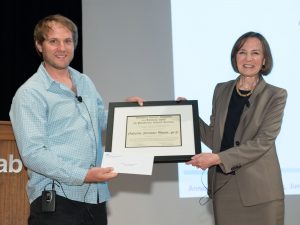Fermilab postdoc Guillermo Fernandez Moroni has received the Universities Research Association (URA) Tollestrup Award for “improving the scientific reach of the SENSEI experiment by three orders of magnitude, achieving the best sensitivity in the world for electron-recoil dark matter searches and for the development of a new low-cost, scalable readout system that will improve the reach of future generations of experiments.”
Scientists infer the existence of dark matter in part through the motions of stars and gas in galaxies. The stars in the outer reaches of our Milky Way are orbiting around the galaxy so fast that the gravitational pull of the other stars and gas in the Milky Way is not strong enough to keep them from flying out of the galaxy. There must be additional matter that we cannot see — hence the moniker dark matter — that helps keep these stars gravitationally bound to the Milky Way.
Currently there is no consensus model for the nature of dark matter. One hypothesis is that dark matter is a new elementary particle that interacts with ordinary matter only rarely, so it’s difficult — but not impossible — for us to detect it in the laboratory.
SENSEI, which stands for Sub-Electron-Noise Skipper CCD Experimental Instrument, aims to observe rare dark matter interactions with ordinary matter by using the individual pixels in a charge-coupled device (CCD) as a target.
CCDs are used in many digital cameras to record light. SENSEI is using them in a novel way to try to record dark matter. When a dark matter particle impinges on the electrons in a CCD pixel, it could knock out an electron, creating a measurable signal that would be the tell-tale sign of dark matter.
That’s right: SENSEI keeps the CCD in the dark, in contrast to the typical use of a CCD to detect light. Instead, the CCDs in SENSEI produce a signal only when a particle directly interacts with the pixel material.
This is where Moroni’s work comes in. The signal that SENSEI is looking for is produced by ejected electrons — ideally ejected by a dark matter particle. However, a quirky aspect of CCDs is that they can randomly eject electrons, producing unwanted background noise, mimicking a dark matter signal at worst and making it more difficult to see one at best.
Moroni was able to track a source of noise in the SENSEI experiment’s sensors down to the detailed structure of individual transistors, enabling scientists to better eliminate it.
“The workaround he developed to overcome this noise improved experimental sensitivity by three orders of magnitude,” said University of California – Davis Professor Michael Mulhearn, Tollestrup Award Committee chair. “Combining a solid grasp of experimental priorities with engineering knowledge to such effect is a remarkable feat.”
With sensitivity improved a thousand-fold, we might be that much closer to homing in on the nature of dark matter.
“Guillermo Fernandez Moroni embodies the spirit of the URA Tollestrup Award, recognizing the truly outstanding work of young scientists at the beginning of their career,” said URA Executive Director Marta Cehelsky.
Moroni’s SENSEI research doesn’t stop with this award-winning work. He’s already begun developing the next generation of the CCD dark matter sensor, a promising advance with vanishingly low noise levels.
About his recognition, Moroni said, “It is a perfect time to stop, look back and say thanks to the family, friends and colleagues who make every day a perfect day.”
The URA Tollestrup Award is given in honor of Alvin Tollestrup, long-time Fermilab employee and winner of the 1989 National Medal of Technology for his work on the Tevatron. The award is given annually at the Fermilab Users Meeting and includes a $5,000 honorarium.




